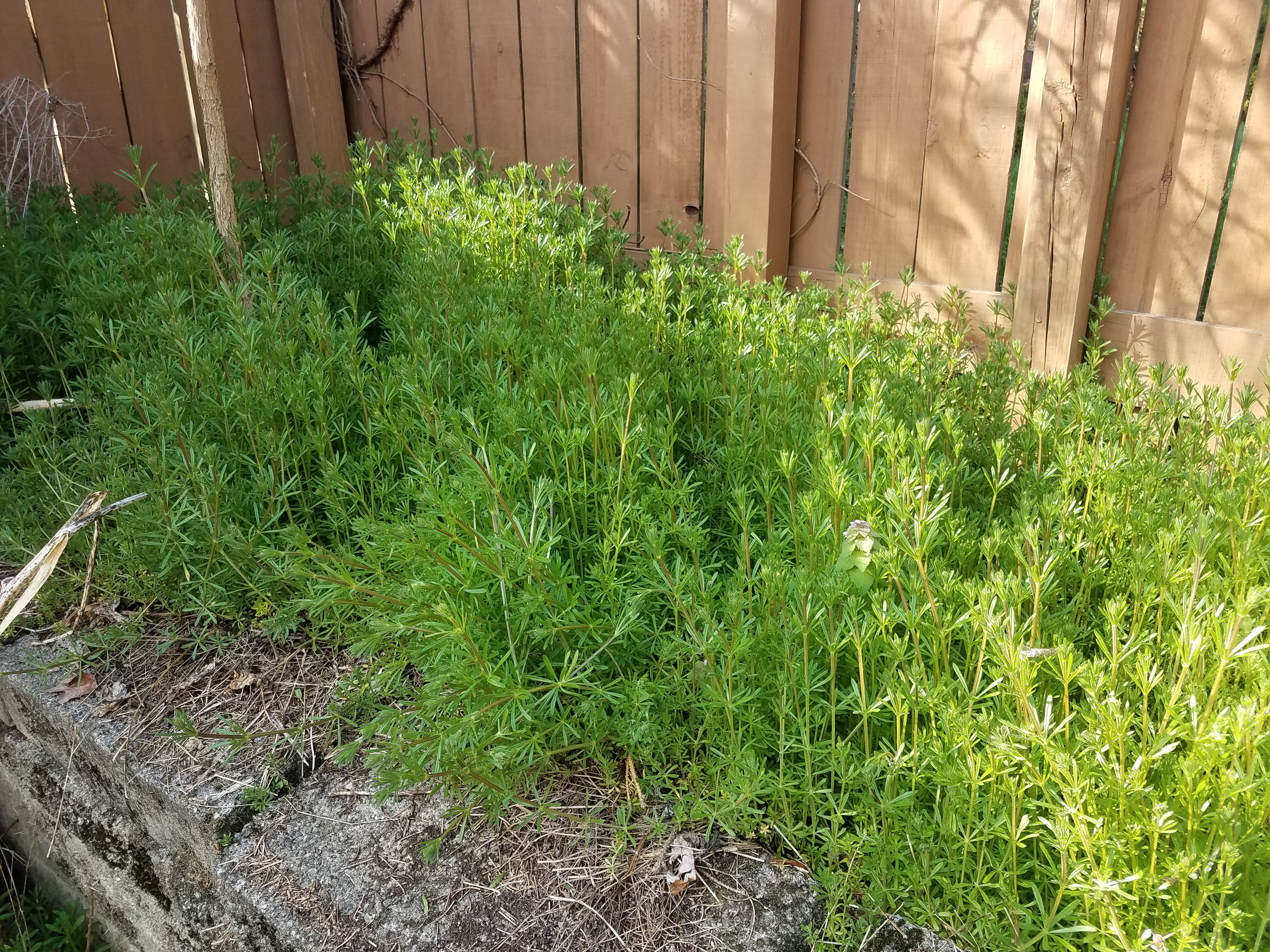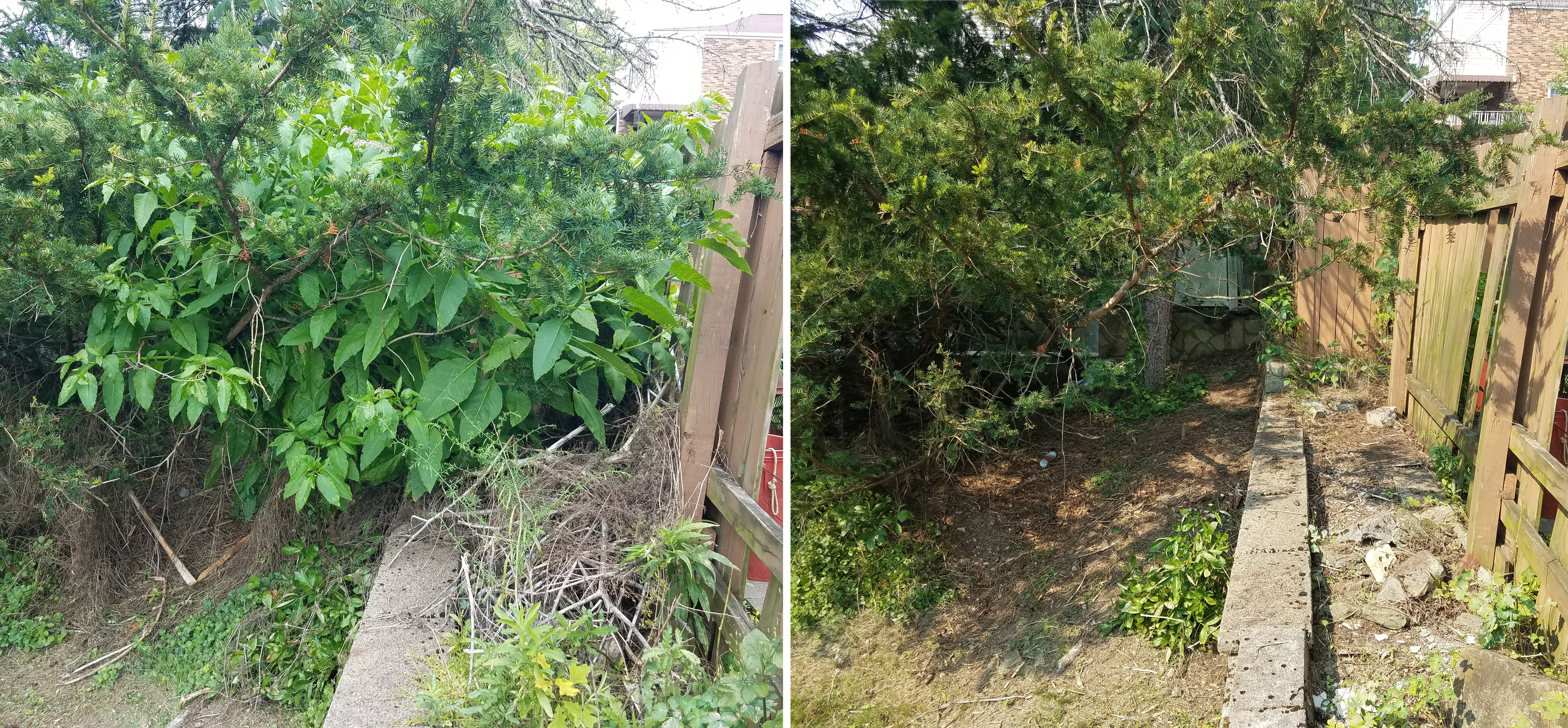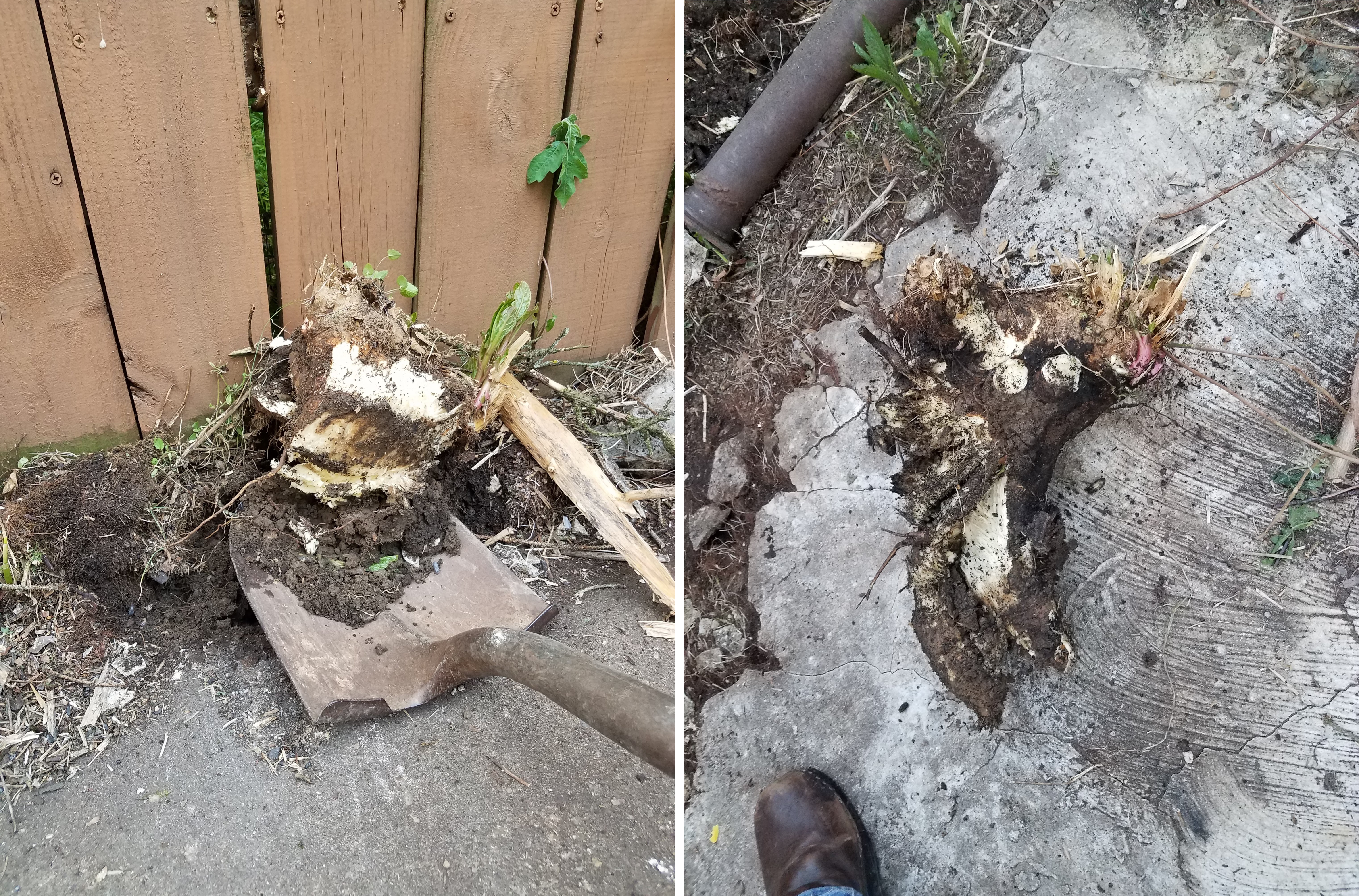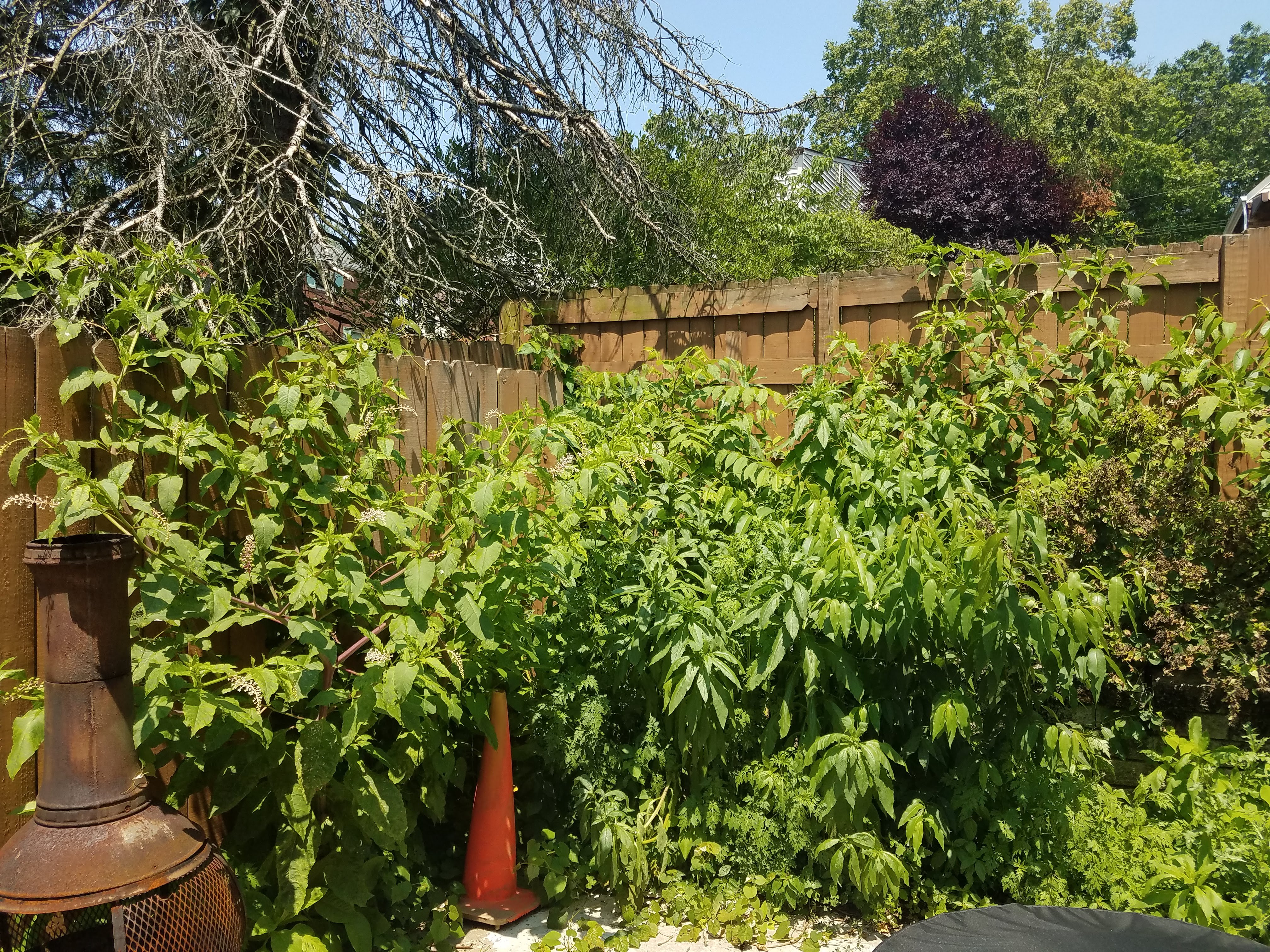Over the past few months, I have been working to channel Marie Kondo, not just in deciding what things I want to keep in my house,[1] but also what activities I want to prioritize as we come out of quarantine.[2] One of those activities is a long list of home improvement projects that have sat on the back burner for years as my social life took priority. I’ve been planning things to do with our back patio since I moved in with Christian five years ago, but I never had time to do it – until now.
I have, on multiple occasions, referred to our house as “DIY Hell.” The previous owner took half measures wherever possible, and the fence in your back yard is no exception. Apparently it was never in good shape, but its condition has only declined since it was first erected (by the owner, who was not handy) on the order of two decades ago. For some time now, I have wanted to take it down and plant a hedge in its place, but first things first: I had to clear the veritable jungle that had grown up around it and prevent any of that jungle from growing back up through my hedge in the future.

I’ve been clearing weeds, vines, and small trees back there starting early in the spring for two years in a row now, thanks to quarantine. But no matter how hard I try to pull things out, I’m never done. I like to think I’ve made more progress this year than last year, but it is slow and frustrating. The vegetation comes in waves: once I clear one thing, something else takes over; once I clear that, something else shows up – including things I took out earlier in the year. And, like fighting a hydra, I know that if I don’t get something torn out before it goes to seed, I know there will be even more of it to deal with next year.
The Wall
With all the quarantine yard work I’ve been doing instead of going out for social activities, I find it amusing that I have now easily met more neighbors than I knew before the pandemic began. Most notable among them is our next door neighbor – let’s call her “M” – with whom we share part of our rickety fence and a retaining wall that runs the length of our property. There seems to be some ambiguity about whose retaining wall it is, though Christian rebuilt it when it collapsed several years ago. Short of getting a formal survey, we seem to have an unspoken understanding that the wall is effectively the dividing line between our yards.
What I do know is that she has a lawn service, much like many of our neighbors. I once asked them what they were spraying, and they couldn’t give me any information more specific than “a mix of fertilizer and weed killer.” That was most certainly unhelpful, but I also know that she uses chemical fertilizers on her plants and has suggested I use weed killers and plastic sheeting to take care of my weeds. Whenever the conversation veers that direction, I try to explain that I only use organic methods over here, and she responds by telling me that she listens to “The Organic Gardener” on the radio [3] and then goes back to recommending things I’m not willing to do.

I’ve honored the wall as a dividing line, but there are invasive weeds along the back of both of our yards. What that means is that even if I clear them on my side, they will continue to encroach over the wall and under the fence. I was also concerned that she might tell her lawn service go to town and start spraying something more insidious, such as glyphosate, to take care of the weeds. In order to preempt that course of action, I specifically asked her if I could hop over the wall and pull some of the weeds we shared. She said she didn’t care.
Catchweed
By the time we had this conversation, it was a little too late in the season for something called catchweed, which was already going to seed. Catchweed, a.k.a. bedstraw, cleavers, aparine, stickywilly, and velcro plant, among other names, is a fast-growing annual that is covered in tiny barbs that stick to everything. If you have sensitive skin, you should absolutely wear long pants and sleeves while tearing it out, and if it comes into contact with your bare skin, wash with soap and water because the millions of micro cuts in your skin will leave an itchy rash.
Although its speed of growth and sticky nature make it incredibly annoying, it has a very small taproot, and it sticks to itself too, making it very easy to tear out. You could spray it with organic weed-killing products, such as BurnOut, which contains citric acid and clove oil,[4] but my experience with sprays is that by the time you’ve sprayed the weed sufficiently, you could have just pulled it out.

The trick to getting rid of it and keeping it away is making sure you pull it before it goes to seed. That happens at different times in different parts of the country (it is everywhere), but here in Pittsburgh, I saw the little green seed balls forming late spring / early summer. Any seeds that do make it into the ground can be viable for up to three years, so you will need to apply regular corn gluten treatments [5] to stop any germinating seeds and keep an eye out for new seedlings for a few years.[6]
Pokeweed
If only the catchweed were the extent of our weed troubles. Far more frustrating is something else that has been looming over the wall (and the fence) and dropping its berries on our side every year: pokeweed. Pokeweed, known by many other names, including American nightshade, is generally toxic. Parts of the plant can be consumed if properly prepared early in the season, but it should be treated with caution, especially if you have curious pets who want to see what those shiny purple berries taste like.
The plant itself can grow as high as 10 feet, producing bunches of purple berries and generating up to 7,000 seeds a year. While seedlings are easy enough to pull by hand, established root systems are incredibly difficult to get rid of and must be dug out in their entirety. Until I can find the time to dig up the roots of the more established plants, I have been cutting ours (and M’s) off at ground level, which is very easy to do with a pair of loppers, as the stems are fleshy and hollow.

If you are able to dig out the roots, do NOT put them directly into a compost or brush pile because they will take root there. Either bag them and put them in your curbside trash or make sure to lay them out in the sun until they are completely dried out. If you don’t get the whole root, the remaining bits may sprout again the following year. I hope to make some progress on the root excavation later this year, but if I am unsuccessful, I may try my hand with horticultural strength (herbicidal) vinegar, which is four times as powerful as household vinegar.
I wish that were all I had to say on pokeweed, but it gets worse: the seeds, which are commonly spread by birds, can stay viable in soil for up to 50 years.[7] At this rate, I’ll be spreading corn gluten well into my retirement, if I’m still around. Maybe by then I’ll have a young, energetic, conscientious, organic gardener on the other side of the fence to take up my mantle in the fight.
I was making some progress in clearing the catchweed and pokeweed (or at least starting to), and I was pleased at the thought that someday I may finally keep our own little jungle at bay… when I noticed something back against our fence – a vine with leaves grouped in threes…
~
This adventure will be continued. In the meantime, what organic methods have you used to tackle weeds in your yard? What weeds are your most formidable opponents? I’d love to hear your battle stories below.
Thanks for reading!
[1] https://radicalmoderate.online/tidying-up-week-1/
[2] https://radicalmoderate.online/414-days-of-solitude/
[3] https://www.audacy.com/kdkaradio/podcasts/the-organic-gardeners-271
[4] http://qr.bonide.com/products/weed-control/view/7468/burnout-formula-ii-conc
[5] https://radicalmoderate.online/eco-friendly-weed-control-2020-update/
[6] http://ipm.ucanr.edu/PMG/PESTNOTES/pn74154.html
[7] http://ipm.ucanr.edu/PMG/PESTNOTES/pn74173.html
0 Comments